What Is The Background To The Beatles

The Beatles "drop T logo"
| The Beatles | |
|---|---|
| Origin | Liverpool, England |
| Genre(s) | Rock and scroll |
| Years active | 1960—1970 1994—1996 (Partial Reunion) |
| Label(s) | Parlophone, Capitol Records |
| Website | Beatles.com |
| Members | |
| John Lennon (1960-1970) Paul McCartney (1960-1970), (1994-1996) George Harrison (1960-1970), (1994-1996) Ringo Starr (1962–1970), (1994-1996) | |
| Former members | |
| Pete Best* (1960–1962) Stuart Sutcliffe (1960–1961) | |
The Beatles were a highly influential English language rock 'n' roll ring from Liverpool. They are the most critically acclaimed and commercially successful pop music ring in music history. The innovative music and manner of John Lennon (1940–1980), Paul McCartney (b. 1942), George Harrison (1943–2001), and Ringo Starr (b. 1940) helped to define the 1960s, and they continue to be well regarded for their artistic achievements, their huge commercial success, their part in the history of popular music, and their contributions to popular civilization.
Contents
- 1 Germination and early years
- 1.ane Hamburg
- 1.ii Recording contract
- i.3 America
- 1.4 Beatlemania
- 1.v Backlash and controversy
- 2 The studio years
- three Breakup
- 4 After the break-up
- 5 Influence
- 6 On film
- 6.1 A Hard Day's Night
- 6.ii Help!
- 6.3 Magical Mystery Tour
- 6.4 Yellow Submarine
- 6.5 Let Information technology Be
- 7 Other projects
- 7.ane Album
- 7.two Love
- 8 Notes
- 9 References
- ten Further reading
- 11 External links
- 12 Credits
The Beatles popularity led the "British Invasion" of United kingdom based bands into the United States in the mid-1960s. Their bear on on society and popular culture continues to the present day through their attitude, appearance, and statements. The rise social consciousness of the mid twentieth century was, in part, moved along by The Beatles' relevance and social awareness, reflected in their music. In big mensurate, as a grouping, they influenced the multitude social and cultural revolutions of the 1960s.
Formation and early on years
In March of 1957, John Lennon formed a "skiffle" group chosen The Quarrymen. On July half dozen of that year, Lennon met Paul McCartney while playing at the Woolton Parish church fete. On February 6, 1958, the young guitarist George Harrison was invited to watch the group perform at Wilson Hall, Garston, Liverpool, and he was shortly a regular player. During this catamenia, members continually joined and left the lineup. Lennon, McCartney, Harrison, and Stuart Sutcliffe, (a classmate of Lennon at Liverpool Art Higher) emerged as the simply constant members. The Quarrymen eventually decided, on August 17, 1960, on the name, "The Beatles."
Hamburg
Their unofficial manager, Allan Williams, arranged for them to perform in clubs on the Reeperbahn in Hamburg, Germany. On August 16, 1960, McCartney invited Pete Best to become the grouping'southward permanent drummer after watching Best playing with The Blackjacks in the Casbah Club. This was a cellar guild operated past Best'south mother Mona, in Westward Derby, Liverpool, where The Beatles had played and oftentimes used to visit. They started in Hamburg by playing in the Indra and Kaiserkeller bars and a order called the Top Ten. Harrison, who was seventeen years former at the time, had lied virtually his age and when discovered, was deported by the German authorities. McCartney and Best started a small-scale burn down in their living quarters while vacating information technology for more luxurious rooms. Arrested and charged for arson, they were both afterwards deported. Lennon and Sutcliffe followed suit and returned to Liverpool in December.
They went dorsum a 2d time and played the Pinnacle Ten club for three months (April-June 1961). During this time period, Stuart Sutcliffe decided to remain in Deutschland to concentrate on painting and left the group. Sutcliffe'due south departure led McCartney to switch from playing rhythm guitar to bass guitar. While they were playing at the Top X, they were recruited past vocalist Tony Sheridan to act every bit his "backing ring" on a series of recordings for the German language Polydor Records label, produced by famed bandleader Bert Kaempfert. Kaempfert signed the grouping to its own Polydor contract at the first session on June 22, 1961. On October 31, Polydor released the recording, My Bonnie (Mein Herz ist bei dir nur), which made information technology into the German charts under the name, Tony Sheridan and The Crush Brothers. Effectually the turn of 1962, My Bonnie was mentioned in Cashbox as the debut of a "new rock and gyre team, Tony Sheridan and the Beatles," and a few copies were too pressed for U.Southward. disc jockeys. Their third stay in Hamburg was from April 13–May 31, 1962, when they opened The Star Club. That stay was dampened when they were informed upon their arrival of Sutcliffe's death from a brain hemorrhage.
Upon their return from Hamburg, the group was enthusiastically promoted by Sam Leach, who presented them for the next year and a one-half on diverse stages in Liverpool forty-ix times. Brian Epstein, manager of the record department at NEMS, his family unit's article of furniture shop, took over every bit the group'south manager in 1962, and led The Beatles' quest for a British recording contract. In 1 at present-famous exchange, a senior Decca Records A&R executive named Dick Rowe turned Epstein down apartment and informed him that "The Decca audition for guitar groups are on the style out, Mr. Epstein."[i]
Recording contract
Epstein eventually met with producer George Martin of EMI's Parlophone characterization. Martin expressed an interest in hearing the ring in the studio. He invited the quartet to London'south Abbey Road studios for an audience on June 6.[2] Martin had not been particularly impressed by the ring'due south demo recordings, merely he instantly liked them when he met them. He concluded that they had raw musical talent, but said (in later interviews) that what fabricated the departure for him that twenty-four hours was their wit and humor in the studio.
Martin privately suggested to Brian Epstein that the band use another drummer in the studio. Best had some popularity and was considered good-looking by many fans, just the 3 founding members had become increasingly unhappy with his popularity and his personality, and Epstein had become exasperated with his refusal to adopt the distinctive hairstyle as role of their unified await. Epstein sacked All-time on August 16, 1962. Lennon and McCartney immediately asked Ringo Starr (aka Richard Starkey), the drummer for one of the meridian Merseybeat groups, Rory Storm and the Hurricanes, to bring together the band. Reluctantly, Rory Tempest let Starkey out of his contract.
The Beatles' first EMI session on June 6 did non yield any releasable recordings, but the September sessions produced a minor Uk hit, "Love Me Do," which peaked on the charts at number 17.[three] The single reached the peak of the The states singles nautical chart more than 18 months later in May 1964. This was swiftly followed by their second unmarried, "Please Please Me." Iii months later they recorded their first album (as well titled Please Please Me). The band'due south first televised performance was on a program called People and Places transmitted live from Manchester by Granada Television on October 17, 1962.[4]
America
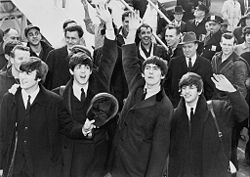
The Beatles, John Lennon, Paul McCartney, George Harrison, and Ringo Starr (Richard Starkey) responding to the welcome from fans at Kennedy Airport in New York Metropolis in February 1964.
Although the band experienced huge popularity in the tape charts in the Uk from early on 1963, Parlophone's American counterpart, Capitol Records (owned by EMI), refused to upshot the singles "Dear Me Do," "Please Please Me," and "From Me to You"[v] in the U.s.a., partly considering no British act had e'er withal had a sustained commercial touch on American audiences.
Vee-Jay Records, a small Chicago label, is said by some to have been pressured into issuing these singles every bit part of a deal for the rights to some other performer's masters. Fine art Roberts, music manager of Chicago powerhouse radio station WLS, placed "Please Please Me" into radio rotation in late February 1963, making information technology possibly the showtime time a Beatles record was heard on American radio. In August 1963, the Philadelphia based Swan Records tried once again with The Beatles' "She Loves You," which also failed to receive airplay.
After The Beatles' huge success in 1964, Vee-Jay Records and Swan Records took advantage of their previously secured rights to The Beatles' early recordings and reissued the songs that they had rights to, which all reached the superlative ten of the charts the 2d fourth dimension around. Vee-Jay ended upwards issuing some odd LP repackagings of the limited Beatles' material they had equally well every bit Introducing… The Beatles, which was substantially The Beatles' debut British anthology with some minor alterations.
Beatlemania
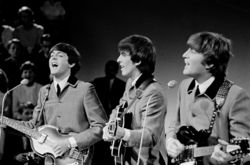
Beatlemania is a term that originated during the 1960s to describe the intense fan frenzy directed toward The Beatles during the early years of their success. The discussion is a portmanteau of "Beatle" and "mania", similar to the much earlier term Lisztomania used to describe fan reaction to the concerts of pianist Franz Liszt.
Andi Lothian, a former Scottish music promoter, laid merits to the term in that he coined 'Beatlemania" while speaking to a reporter on October 7, 1963 at the Caird Hall in Dundee at a Beatles concert which took place during The Beatles' 1963 Mini-Tour of Scotland,[6]
In early November 1963, Brian Epstein persuaded Ed Sullivan to commit to presenting The Beatles on three editions of his show in Feb, and parlayed this guaranteed exposure into a record deal with Capitol Records. Capitol committed to a mid-Jan 1964 release for "I Want to Hold Your Hand,"[half dozen] just a series of unplanned circumstances triggered premature airplay of an imported re-create of the single on a Washington D.C. radio station in mid-December. Capitol brought forward the release of the record on Dec 26, 1963.[7]
Several New York City radio stations—starting time WMCA, then WINS, and finally WABC (AM) began playing "I Want to Concord Your Manus" on its release day. The Beatlemania that had started in Washington was duplicated in New York and rapidly spread to other markets. The record sold i million copies in merely 10 days, and by January 16, Cashbox Magazine had certified The Beatles tape every bit number one in the edition published with the comprehend-date January 23, 1964.
This contributed to the almost hysterical fan reaction on February 7, 1964 at John F. Kennedy International Airport (which had been renamed in December 1963 from Idlewild Airport). A record-breaking seventy-three million viewers, approximately 40 per centum of the U.S. population at the time, tuned into the first Ed Sullivan Bear witness appearance two days subsequently February ix. During the calendar week of April iv, The Beatles held the summit 5 places on the Billboard Hot 100, a feat that has never been repeated. They had an additional 7 songs at lower positions. Of all the music acts on the charts, 12 percentage of the entries consisted of Beatles songs.[8] They were and so unaware of their popularity in America that, on their arrival, they initially thought the crowds were there to greet someone else.
In the summer of 1964, the band undertook their first appearances outside of Europe and North America, touring Australia and New Zealand, notably without Ringo Starr who was ill and was temporarily replaced by session drummer Jimmy Nicol. When they arrived in Adelaide, The Beatles were greeted by what is reputed to exist the largest crowd of their touring career, when over 300,000 people turned out to come across them at the Adelaide Town Hall.[9] At that time, Adelaide's population was roughly 200,000. In September of that year, baseball game owner Charles O. Finley paid the ring the then unheard of sum of $150,000 to play in Kansas City, Missouri.
In 1965, Elizabeth Ii of the U.k. bestowed upon them the Member of the Order of the British Empire or MBE, a ceremonious honor nominated by Prime number Minister Harold Wilson.
On August 15, of that year, The Beatles performed in the starting time stadium rock concert in the history of rock, playing at Shea Stadium in New York to a crowd of 55,600.[x] The ring after admitted that they had been largely unable to hear themselves play or sing, due to the screaming and cheering. This concert is generally considered the point at which their disenchantment with performing live began.
Backlash and controversy
In July 1966, when The Beatles toured the Philippines, they unintentionally snubbed the nation'due south first lady, Imelda Marcos, who had expected the group to nourish a breakfast reception at the Presidential Palace. Managing director Brian Epstein was forced to requite dorsum all the money that the band had earned while they were there before beingness allowed to leave the country.[11]
Most as soon as they returned from the Philippines, an before comment past John back in March of that twelvemonth launched a backlash against The Beatles. In an interview with British reporter Maureen Cleave, Lennon had offered his opinion that Christianity was dying and that The Beatles were "more pop than Jesus now."[12]
There was an immediate response, starting with an announcement by 2 radio stations in Alabama and Texas that they had banned Beatles' music from their playlists. WAQY DJ, Tommy Charles: "We merely felt it was so cool and sacrilegious that something ought to be done to bear witness them that they can't become away with this sort of thing".[13] Around two dozen other stations followed suit with similar announcements. Some stations in the South went further, organizing demonstrations with bonfires, drawing hordes of teenagers to publicly burn down their Beatles' records and other memorabilia. Many people affiliated with churches in the American Southward took the proposition seriously.[14]
The Memphis city council, aware that a Beatles' concert was scheduled at the Mid-Southward Coliseum during the group's imminent US bout, voted to abolish it rather than accept "municipal facilities be used every bit a forum to ridicule anyone's religion", and too saying, "The Beatles are non welcome in Memphis".[15] The Ku Klux Klan nailed a Beatles' anthology to a wooden cantankerous, vowing "vengeance", with conservative groups staging further public burnings of Beatles' records.
Young people across the United states of america and South Africa burned Beatles records in protestation. Under tremendous pressure from the American media, Lennon apologized for his remarks at a press conference in Chicago on August xi, the eve of the first operation of what turned out to be their final tour.
The studio years
The Beatles performed their last concert before paying fans at Candlestick Park in San Francisco on August 29, 1966. From so they concentrated on recording music, in the process pioneering more than advanced, multi-layered arrangements in popular and pop music. After iii months abroad from each other, they returned to Abbey Road Studios on Nov 24, 1966, to begin a 129-24-hour interval recording period in making their eighth anthology: Sgt. Pepper's Lone Hearts Club Band, released on June ane, 1967.[xvi]
On June 25, 1967, the Beatles became the start band globally transmitted on television, in front of an estimated 400 million people worldwide. The band appeared in a segment within the starting time-ever worldwide TV satellite hook-upwardly, a show entitled Our Earth. The Beatles were transmitted live from Abbey Road Studios, and their new song "All You Need Is Love" was recorded live during the bear witness.
Following the triumphs of the Sgt. Pepper album and the global circulate, The Beatles' situation worsened. First, their director Brian Epstein died of an overdose of sleeping pills on August 27, 1967, at the historic period of 32, and the band'south business organization affairs began to unravel. Next, at the end of 1967, they received their commencement major negative press criticism in the Britain, with disparaging reviews of their surrealistic TV film Magical Mystery Bout.[17] The film was besides panned past the public.
The group spent the early on part of 1968 in Rishikesh, Uttar Pradesh, Republic of india, studying transcendental meditation with the Maharishi Mahesh Yogi. Upon their return, Lennon and McCartney formed Apple Corps, initially an donating business venture which they described every bit an attempt at "western communism." The eye office of 1968 saw the band decorated recording the double album, The Beatles, popularly known as "The White Album" due to its stark white cover. These sessions saw deep divisions opening within the band, some of which included Lennon'south new girlfriend, Yoko Ono, being at his side through much of the sessions and the feeling that McCartney was condign too dominating.[xviii]
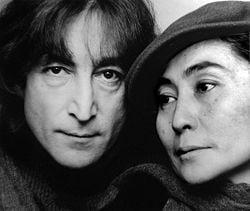
McCartney gradually took greater charge of the grouping. Internal divisions within the band had been a pocket-size but growing trouble during their earlier career. Most notably, this was reflected in the difficulty that George Harrison experienced in getting his songs onto Beatles' albums, and in the growing artistic and personal estrangement between Lennon and McCartney.
On the business side, McCartney wanted Lee Eastman, the father of his married woman, Linda Eastman, to manage The Beatles, only the other Beatles wanted New York manager Allen Klein to represent them. All Beatles decisions in the by were unanimous but this fourth dimension the 4 could not agree on a director. Lennon, Harrison, and Starr felt the Eastmans would look after McCartney'due south well-beingness before that of the group. Paul was quoted years later during the Anthology interviews, maxim that "Looking back, I tin can sympathize why they would feel that was biased against them." The group later repented on the Klein decision, equally Klein embezzled millions from their earnings.
Their concluding live performance was on the rooftop of the Apple edifice in Savile Row, London, on January 30, 1969, the side by side-to-concluding day of the difficult Become Dorsum sessions. Largely due to McCartney'southward efforts, they recorded their concluding album, Abbey Road, in the summer of 1969.
Breakup
John Lennon announced his departure to the rest of the grouping on September 20, 1969, but was talked out of saying anything publicly. In March 1970, the Get Back session tapes were given to American producer Phil Spector, whose "Wall of Sound" production was in direct opposition to the original intent that the record appear as a stripped-down live studio performance. McCartney publicly appear the break-up on April 10, 1970, a calendar week before releasing his first solo album, McCartney. On May 8, 1970, the Spector-produced version of Get Dorsum was released as the album Let It Exist, followed by the documentary film of the same name. The Beatles' partnership was legally dissolved after McCartney filed a lawsuit on December 31, 1970.
Afterwards the break-upwards
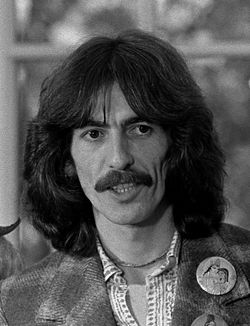
Following the dissolution of the group, the BBC marketed a large collection of Beatles recordings, mostly comprising original studio sessions from 1963 to 1968. Much of this material formed the basis for a 1988 radio documentary series, The Beeb'due south Lost Beatles Tapes. Later, in 1994, the all-time of these sessions were given an official EMI release on Alive at the BBC.
In February 1994, the then-three surviving Beatles reunited to produce and record additional music for a few of Lennon's old unfinished demos, well-nigh every bit if reuniting the Beatles. "Free As A Bird" premiered as part of The Beatles Anthology which was a series of telly documentaries and was released equally a single in Dec 1995, with "Real Love" following in March 1996. These songs were also included in the iii Album collections of CDs released in 1995 and 1996, each of which consisted of two CDs of never-before-released Beatles cloth.
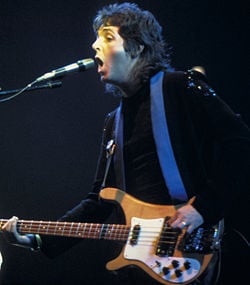
Paul McCartney during a Wings concert in 1976. Photograph by Jim Summaria.
The Beatles continued to absorb influences throughout their career, long after their initial success, frequently finding new musical and lyrical avenues to explore from listening to the work of some of their contemporaries. Among those influences were Bob Dylan, on songs such equally "You've Got to Hide Your Dear Away," "Assistance!," "Norwegian Wood (This Bird Has Flown)," and "Condom Soul." Dylan introduced The Beatles to the cannabis drug (1964) in a New York hotel room. He offered the "Fab Four" marijuana as a result of his misconception that the lyrics in their striking song "I Want to Hold Your Hand" from Meet the Beatles! were "I go loftier" instead of "I can't hibernate." This initial partaking in drugs grew into heavier experimentation with LSD and diverse other substances whose psychedelic effects were commonly thought to take manifested themselves in the ring's music. The Beatles, in turn, would influence Dylan'due south movement into an electrified rock sound in his music.
In 1965, having recently become interested in Indian music, George Harrison purchased a sitar, which he played in the song Norwegian Wood (This Bird Has Flown), the first instance of such an instrument beingness used on a stone record. He later took sitar lessons from maestro Ravi Shankar, and implemented farther elements of Eastern music and spirituality into his songs, notably Dear You lot To and Inside You Without You. These musical decisions greatly increased the influence of Indian music on popular civilization in the late 1960s.
Along with studio tricks such as audio furnishings, anarchistic microphone placements, automatic double tracking, and vari-speed recording, The Beatles began to augment their recordings with instruments that were unconventional for rock music at the time. These instruments included string and brass ensembles, Indian instruments such as the sitar and the "swarmandel," tape loops, and early electronic instruments including the "Mellotron," which was used with flute voices on the intro to "Strawberry Fields Forever." McCartney one time asked Martin what a guitar would sound similar if it was played underwater, and was serious near trying information technology. Lennon likewise wondered what his vocals would sound like if he was hanging upside downwardly from the ceiling. Clearly their ideas were out-stripping the technology that was available at the time.
Lennon is portrayed as having played the major role in steering The Beatles towards psychedelic music in Rain and Tomorrow Never Knows from 1966, Lucy in the Sky with Diamonds, Strawberry Fields Forever, and I Am the Walrus, from 1967. Additionally, McCartney was likewise influential, being involved in the London avant garde scene, which was itself moving towards psychedelia during the same menstruation.
Get-go with the apply of a string quartet (arranged past George Martin) on Yesterday in 1965, The Beatles pioneered a modern form of art rock and art song, exemplified by the double-quartet cord arrangement on "Eleanor Rigby" (1966), "Here, There and Everywhere" (1966), and "She'due south Leaving Home" (1967). Lennon and McCartney's involvement in the music of Johann Sebastian Bach led them to use a piccolo trumpet on the organization of "Penny Lane" and a Mellotron at the start of "Strawberry Fields Forever."
Influence
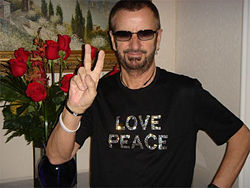
Ringo Starr in 2007. Photograph by Tina 63.
The Beatles were the best-selling popular musical act of the twentieth century. In the Britain lonely, they released more than 40 different The Beatles discography of singles, and The Beatles discography of albums, too as The Beatles discography of Extended plays (EPs) that reached UK Singles Chart every bit number one. This commercial success was repeated in many other countries. EMI estimated that by 1985, the band had sold over one billion discs or tapes worldwide. The Recording Industry Association of America has certified The Beatles as the tiptop selling artists of all time in the Usa based on U.S. sales of singles and albums.[xix]
Anthology ane sold 450,000 copies on its starting time 24-hour interval of release, reaching the highest volume of single-day sales ever for an anthology. In 2000, a compilation album named ane was released, containing almost every number-ane single released past the ring from 1962 to 1970. The collection sold 3.6 million copies in its commencement week and more 12 million in iii weeks worldwide, becoming the fastest-selling album of all time and the biggest-selling anthology of the year 2000. The drove likewise reached number 1 in the U.s.a. and 33 other countries. In 1988, every fellow member of the Beatles (including Pete Best and Stuart Sutcliffe) were inducted into the Rock and Curl Hall of Fame.
The group's influence on Rock and roll, rock music and popular culture was and remains immense. Their commercial success started an almost immediate wave of changes—including a movement from Usa global say-so of rock and roll to U.k. acts, from soloists to groups, through professional songwriters to self-penned songs and to changes in fashion.
The group is typically ranked very high on many "best e'er" music lists. Below are examples of The Beatles recognition.
On Rolling Stone Magazine's "500 greatest albums of all fourth dimension listing," The Beatles had a total of 11 albums on the listing with iv of them in the top 10 (far more than whatever other artist on the list). They were: Sgt Pepper'southward Solitary Hearts Club Band at #ane, Revolver at #3, Rubber Soul at #v, The Beatles (The White Album) at #10, Abbey Road at #14, Please Please Me at #39, Run across The Beatles! at #59, Let It Be at #86, Aid! at #332, A Hard Day's Night at #388, and With The Beatles at #420.
On VH1'southward "100 Greatest Albums" list The Beatles had five albums on the list, 4 in the top 10 and one in the top 20. They were: Revolver at #1, Rubber Soul at #6, Abbey Road at #viii, Sgt Pepper'southward Solitary Hearts Club Band at #10, and The Beatles (The White Anthology) at #11.
In 2004, The Beatles came in at the very meridian of Rolling Stone Magazine's 100 Greatest Artists of All Fourth dimension list.[20]
The Beatles were ranked #1 on VH1's "100 greatest artists of Rock N' Roll" (they were also ranked #i on the net's corresponding poll).
VH1'south "100 Greatest Rock Songs" included: Hey Jude at #8, Yesterday at #12, A 24-hour interval In The Life at #20, I Want To Hold Your Hand at #23, Let It Be at #32, Twist And Shout at #57, She Loves You at #59, Strawberry Fields Forever at #61, and A Hard Twenty-four hour period's Nighttime at #79.
Rolling Stone and MTV's "100 Greatest Pop Songs" included: Yesterday at #1, I Desire To Hold Your Hand at #6, and In My Life at #63.
The Beatles' many achievements included being the first British rock grouping to achieve worldwide prominence, launching a British invasion that made stone a truly international phenomenon. Even after their breakup in 1970, the Beatles continued to be heard on radio in heavy rotation, connected to sell records in massive quantities, and continued to exist quoted past countless pop and stone artists to this mean solar day. In January 2007, the British Post Office released stamps with images of half dozen Beatles album covers.[21]
On film
The Beatles appeared in several films, most of which were very well received. The exception was the (mostly unscripted) television film Magical Mystery Tour which was panned by critics and the public alike. All of their films had the aforementioned name every bit their associated soundtrack albums and a song on that album.
A Hard 24-hour interval's Dark
The Beatles had a successful flick career, beginning with A Difficult Day'southward Night released in 1964, a loosely scripted comic farce, favorably compared to the Marx Brothers in fashion. Information technology focused on Beatlemania and their hectic touring lifestyle. The moving-picture show was directed in a quasi-documentary manner in blackness-and-white by the upwards-and-coming Richard Lester, who was known for having directed a tv version of the successful BBC radio series, The Goon Evidence, as well as the off-crush short film, The Running, Jumping and Standing However Moving-picture show, with Spike Milligan.
Help!
In 1965 came Help! an Eastmancolour extravaganza, which was as well directed past Lester. The picture show was shot in exotic locations (such as Salisbury Patently, with Stonehenge visible in the background; the Bahamas; and Salzburg and the Tyrol region of the Austrian Alps) in the way of a James Bond spoof forth with even more Marx Brothers–way zaniness. For example, the motion picture is defended "to Elias Howe, who, in 1846, invented the sewing automobile."
In late 1966, John Lennon took time off to play a supporting grapheme, Gripweed, in the film called How I Won the War, once more directed by Lester. It was a satire of Earth War Ii films, and its dry, ironic British sense of humour was not well received by American audiences.
Magical Mystery Tour
The Magical Mystery Bout film was essentially McCartney's idea, loosely inspired by McCartney'southward knowledge of Ken Kesey'southward Merry Pranksters, an LSD–fueled American passenger vehicle odyssey.[22] McCartney felt inspired to take this idea and blend information technology with the peculiarly English working class tradition of "double-decker" mystery tours, in which children took chaperoned autobus rides through the English language countryside, destination unknown. The film was critically dismissed when it was aired on the BBC's premier television network, BBC-1. While the moving-picture show has historical importance as an early accelerate into the music video age, many viewers found it defective a plot and, thus, confusing.
Yellow Submarine
The blithe pic, Yellow Submarine, followed in 1968, but had lilliputian direct input from The Beatles, save for a alive-action epilogue and the contribution of 4 new songs (including Just a Northern Vocal, an unreleased track from the Sgt. Pepper sessions). It was acclaimed for its boldly innovative graphic style and especially stinging pangs of heartbreak, along with the soundtrack. The Beatles are said to have been pleased with the result and attended its highly publicized London premiere. Every one of The Beatles idea their own voices (narrated by actors) were not quite correct, while maxim that the other three were perfect.
In 1969, Ringo Starr took second billing to Peter Sellers in the satirical film comed,y The Magic Christian, in a function which had been written especially for him. In 1971, Starr played the part of Frank Zappa in Zappa's epic cult film almost a stone and roll band touring, entitled 200 Motels. Starr later embarked on an irregular career in comedy films through the early 1980s, and his interest in the subject led him to be the well-nigh active of the group in the film division of Apple Corps, although it was George Harrison who would achieve the most success every bit a film producer.
Let It Be
Permit It Be was an ill-fated documentary of the band that was shot over a four-week catamenia in January 1969. The documentary, which was originally intended to be simply a chronicle of the evolution of an album and the band's possible render to live performances, captured the prevailing tensions between the band members, and in this respect it unwittingly became a document of the beginning of their intermission-up.
The band initially rejected both the pic and the album, instead recording and issuing the Abbey Road album. Just with so much money having been spent on the project, it was decided to finish, and release, the flick and album (the latter with considerable mail-product by Phil Spector) in the spring of 1970. When the flick finally appeared, it was later on the break-up had been announced.
Other projects
Anthology
Approximately coinciding with the release of the Costless as a Bird unmarried and Anthology ane album (the first of iii double-CD albums), The Beatles Anthology, which is a series of documentaries was broadcast on television in 1995. The serial, which was made over five years of planning and production (1,760 minutes), collected together numerous motion picture clips and interviews to present a complete history of the band from The Beatles' own personal perspectives.
Love
Love is a 2006 theatrical product by Cirque du Soleil which combines the re-produced and re-imagined music of The Beatles with an interpretive, circus-based artistic and athletic stage performance. The production is a articulation venture betwixt Cirque du Soleil and The Beatles' Apple Corps Ltd, and is the first production that Apple Corps Ltd. has partnered. Love plays at a particularly-built theater at The Delusion in Las Vegas.
The music for the show was produced, arranged, and remixed by Sir George Martin and his son, Giles Martin, with the approval and encouragement of Paul McCartney, Olivia Trinidad Arias Harrison (George Harrison'southward widow), Ringo Starr, and Yoko Ono, executrix of the John Lennon manor. The Martins made apply of the original studio multitrack tapes to produce remixed and re-imagined versions of the songs selected. The Beatles soundtrack anthology of the show was released in Nov 2006.
Notes
- ↑ The Beatles, The Beatles Anthology (Chronicle Books, LLC, 2000).
- ↑ Hunter Davies, The Beatles (1981), p. 178.
- ↑ Robert Fontenot, Honey Me Do, About.com: Oldies music. Retrieved May 22, 2007.
- ↑ Nib Harry, The Ultimate Beatles Encyclopedia, p. 516.
- ↑ www.jpgr.co.uk, JPGR Retrieved May 22, 2007.
- ↑ 6.0 6.1 Kathryn Mainds, Radio interview, Radio Tay AM, Radio Tay Interview. Retrieved October 3, 2011
- ↑ Robert Fontenot, I Want To Concord Your Hand, About.com: Oldies Music. Retrieved May 23, 2007.
- ↑ Shorty Blackwell, Billboard Charts Issue for calendar week ending April iv, 1964 Hot 100 Singles, alt.music.beatles. Retrieved May 23, 2007.
- ↑ P. Ficher and K.H. Seamark, Vintage Adelaide (East Street Publications, 2005, ISBN 1921037067).
- ↑ Keith Badman, The Beatles Off The Tape (London: Charabanc Printing, 2000, ISBN 0711979855).
- ↑ The Beatles Anthology.
- ↑ Maureen Cleave, How Does a Beatle Alive? John Lennon Lives Like This, London Evening Standard. Retrieved on September 16, 2006.
- ↑ Gould 2008, pp. 340-341.
- ↑ Cross 2005, p. 176.
- ↑ Wiener 1991, p. 12.
- ↑ Bob Spitz, The Beatles: The Biography (Fiddling Brownish, ISBN 0316803529).
- ↑ Marmalade Skies, Magical Mystery Tour. Retrieved May 15, 2008.
- ↑ Bob Spitz, The Beatles: The Biography (Little Brown, ISBN 0316803529).
- ↑ www.riaa.com, Best Sellers: Golden & Platinum Height Artists. Retrieved on September xvi, 2006.
- ↑ Rolling Stone, The Immortals: The Outset 50. Retrieved December 21, 2006
- ↑ Ritchie Unterberger, The Beatles Biography. Retrieved May 23, 2007.
- ↑ Television Heaven, Magical Mystery Tour. Retrieved May 24, 2007.
References
ISBN links support NWE through referral fees
- Bramwell, Tony. Magical Mystery Tours. St. Martin'south Press, 2005. ISBN 0312330439.
- Braun, Michael. Love Me Do: The Beatles' Progress'. London: Penguin Books, 1964. ISBN 0140022783.
- Carr, Roy, and Tony Tyler. The Beatles: An Illustrated Record. Harmony Books, 1975. ISBN 0517520451.
- Cross, Craig. The Beatles: Day by Day, Song past Song, Record by Record. Universe, Inc., 2005. ISBN 0595346634.
- Davies, Hunter. The Beatles. McGraw-Colina, 1985. ISBN 0070154635.
- Emerick, Geoff, and Howard Massey. Here, There and Everywhere: My Life Recording the Music of The Beatles. Gotham Books, 2006. ISBN 1592401791.
- Goldsmith, Martin. The Beatles Come To America. Turning Points: 2004. ISBN 0471469645.
- Lewisohn, Mark. EMI's The Complete Beatles Recording Sessions: The Official Story of the Abbey Road Years. Hamlyn, 1990. ISBN 0681031891.
- MacDonald, Ian. Revolution in the Caput: The Beatles' Records and the Sixties. Vintage, 1995. ISBN 0712666974.
- Martin, George. Summer of honey: The Making of Sgt. Pepper. Macmillan: 1994. ISBN 0333603982.
- Norman, Philip. Shout: The Beatles in Their Generation. MJF Books, 1997. ISBN 1567310877.
- Schaffner, Nicholas. The Beatles Forever. Cameron House, 1977. ISBN 0811702251.
- Spitz, Bob. The Beatles. Little Dark-brown, 2005. ISBN 0316803529.
- Lewis, Martin. "The Apollonian Spirit of the Beatles." Variety, October xvi, 2005. Retrieved Nov 25, 2015.
Further reading
- Turner, Steve. The Gospel co-ordinate to the Beatles. Westminster: John Knox Printing, 2006. ISBN 0664229832.
- The Beatles. The Beatles Anthology. Chronicle Books: LLC, 2000. ISBN 0811826848.
- Emerick, Geoff, and Howard Massey. Hither, In that location and Everywhere: My Life Recording the Music of The Beatles. New York: Gotham Books, 2006. ISBN 1592401791.
- Spitz, Bob. The Beatles. Little, Brownish, 2005. ISBN 0316803529.
- Turner, Steve. A Hard Mean solar day's Write, 3rd ed. New York: Harper Paperbacks, 2005. ISBN 0060844094.
- Dimery, Martin. Beingness John Lennon. SAF books, 2002. ISBN 0946719438.
- Porter, Alan J. Before They Were Beatles: The Early Years 1956-1960. Xlibris. ISBN 1413430562.
- Ryan, Kevin, and Brian Kehew. Recording the Beatles: The Studio Equipment and Techniques Used to Create Their Archetype Albums. Los Angeles: Curvebender Publishing, 2006. ISBN 0978520009.
External links
All links retrieved January 24, 2020.
- The Beatles Official site
- The Internet Beatles Album
- The Beatles' "Abbey Road" on TIME'due south 100 Best Albums listing
Credits
New World Encyclopedia writers and editors rewrote and completed the Wikipedia article in accordance with New World Encyclopedia standards. This article abides past terms of the Creative Commons CC-by-sa three.0 License (CC-by-sa), which may be used and disseminated with proper attribution. Credit is due under the terms of this license that can reference both the New Earth Encyclopedia contributors and the selfless volunteer contributors of the Wikimedia Foundation. To cite this article click here for a listing of acceptable citing formats.The history of before contributions by wikipedians is accessible to researchers here:
- The Beatles history
The history of this article since it was imported to New World Encyclopedia:
- History of "The Beatles"
Note: Some restrictions may apply to use of individual images which are separately licensed.
What Is The Background To The Beatles,
Source: https://www.newworldencyclopedia.org/entry/The_Beatles
Posted by: warrendanythas.blogspot.com


0 Response to "What Is The Background To The Beatles"
Post a Comment